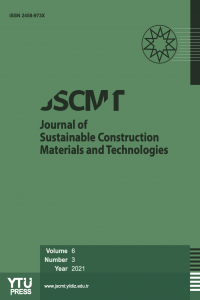Acoustic Property of NBRRI Interlocking Compressed Stabilized Earth Blocks (ICSEB): A Sustainable Alternative for Building Materials
Acoustic Property of NBRRI Interlocking Compressed Stabilized Earth Blocks (ICSEB): A Sustainable Alternative for Building Materials
___
- 1. Jagadish K. S. (2007). Building with stabilized mud. I.K. International Publishing House Pvt. Ltd.
- 2. Riza, F.V. (2011). Preliminary Study of Compressed Stabilized Earth Bricks (CSEB). Australian Journal of Basic and Applied Sciences, 5(9), 6-12.
- 3. National Building Code (2016). Federal Republic of Nigeria National Building Code. Alexi Nexis, Butter- worths.
- 4. Didel J. M, Matawal D. S., & Ojo E. B. (2014). Comparative cost analysis of compressed stabilized blocks and sandcrete blocks in affordable housing delivery in Nigeria. Proceedings of International Housing Summit on Achieving.
- 5. Qu, B., Stirling, B. J., Laursen, P. T., Jansen, D. C., & Bland, D. W. (2012). Interlocking compressed earth block walls: in-plane structural response of flexure-dominated walls. 15th World Conference on Earthquake Engineering. Lisbon, Portugal.
- 6. NBRRI Mandate (2022). https://nbrri.gov.ng/new.
- 7. Suhamad, D. A., & Martana, S. (2020). Sustainable building materials. IOP Conference Series Materials Science and Engineering, 879, Article 012146. [CrossRef]
- 8. Selvamurugan, M., & Pramasivam, S. (2019). Bioplastics – an eco-friendly alternative to petrochemical plastics. Current World Environment 14, 49-59. [CrossRef]
- 9. Smardzewski, J., Kamisi ń ski, T., Dziurka, D., Mir- ski, R., Majewski, A., Flach, A., & Pilch, A. (2015). Sound absorption of wood-based materials. Holzfor- schung, 69, 431-439. [CrossRef]
- 10. Eires, R., Sturm, T. Camoes, A., & Ramos, L. F. (2012). Study of a new interlocking stabilized compressed earth blocks. https://www.researchgate.net/ publication/264119160_Study_of_a_new_inter- locking_stabilised_compressed_earth_blocks
- 11. Leitão, D., Sá, A. B., Soares, E., & Miranda, T. (2016). Thermal and acoustic performance of interlocking compressed earth blocks masonry. 41st IAHS World Congress on Sustainability and Innovation for the Future, 1-14.
- 12. Mansour, M. B., Ogam, E., Jelidi, A., Cherif, A.S., & Ben, J. S., (2017). Influence of compaction pressure on the mechanical and acoustic properties of compacted earth blocks: an inverse multi-pa- rameter acoustic problem. Applied Acoustics, 125, 128-135. [CrossRef ]
- 13. ASTM D-2487-17 (2020): Standard Practice for Classification of Soil for Engineering Purposes (Unified Soil Classification System). ASTM. https://www. astm.org/d2487-17.html
- 14. Zingfat M. J., Mailafiya B.Y., Garnvwa J. D., & Py- endang Z. S. (2023). Capillary absorption of NBRRI interlocking compressed stabilized earth blocks. African Journal of Environment and Natural Science Research, 6, 36-42. [CrossRef]
- 15. ASTM Standard E1050-98 (2017): Standard Test Method for Impedance and Absorption of Acoustical Materials Using a Tube, Two Microphones, and a Digital Frequency Analysis system. ASTM. https:// www.astm.org/e1050-98.html
- 16. ISO 10534-2:1998. Acoustic – Determination of Sound absorption Coefficient and Impedance in Impedance Tubes. ISO. https://www.iso.org/stan- dard/22851.html
- 17. Onaolapo, A. (2010). Modification and Testing of a Laterite-Cement Brick Moulding Machine. Master’s thesis, University of Ilorin Nigeria].
- 18. Öser, C. (2020): Determining the plasticity properties of high plastic clays: a new empirical approach. Arabian Journal of Geosciences, 13, Article [CrossRef ]
- 19. Bakam V. A., Mbishida M. A., Danjuma T., Zingfat M. J., Hamidu L. A. J., & Pyendang Z. S. (2020). De- termination of thermal conductivity of interlocking compressed stabilized earth block (CSEB). International Journal of Recent Engineering Research and Development (IJRERD), 5(1), 1-8.
- 20. Sujon, M.A.S., Islam, A., & Nadimpalli, V.K. (2021). Damping and sound absorption properties of poly- mer matrix composites: a review. Polymer Testing, 104, Article 107388. [CrossRef]
- 21. Amares, S., Sujatmika, E., Hong, T.W., Durairaj, R., & Hamid, H.S.H.B. (2017). a review: characteristics of noise absorption material. Journal of Physics: Conference Series - Institute of Physics. https://iopscience. iop.org/article/10.1088/1742-6596/908/1/012005/ pdf. [CrossRef ]
- 22. Liu, P. S., & Chen, G. F. (2014). Building decorative materials. Application of porous metals. In porous materials. Elsevier. [CrossRef]
- 23. Patil, S. V., & Kurbet, S. N. (2020). Determination of absorption coefficient of acoustic materials by prototype impedance tube. International Journal of Engineering Development and Research, 8(2), 457.
- 24. Bhatia, A. (2020). M06-026: HVAC systems noise control Lecture Note.. Continuing Education and Development, Inc. https://www.cedengineering. com/userfiles/HVAC%20Systems%20Noise%20 Control.pdf.
- 25. Demi. O. (2018,). What is the Acoustic Absorption Coefficient? Commercial Acoustics. https://com- mercial-acoustics.com/acoustic-absorption-coef- ficient/.
- 26. Rivera-Gómez, C., Galán-Marín, C., López-Cabe- za, V. P., & Diz-Mellado, E. (2021). Sample key fea- tures affecting mechanical, acoustic and thermal properties of a natural-stabilised earthen material. Construction and Building Materials, 271, Article 121569. [CrossRef ]
- 27. Silva, R. A., Oliveira, D. V., Miranda, T. F., Esteves, P., Soares, E., & Cristelo, N. (2014). Mechanical behavior of compressed earth blocks stabilized with industrial wastes. 14 Congresso Nacional de Geotecnia, 16-24.
- 28. Ouma, J., Ongwen, N., Ogam, E., Auma, M., Fel- lah, Z. E., Mageto, M., Mansour, M., & Oduor, A., (2023). Acoustical properties of compressed earth blocks: effect of compaction pressure, water hya- cinth ash and lime. Case Studies in Construction Materials, 18(4), e01828. [CrossRef]
- 29. High Performance Fiber Glass Batts. (2023). Certainteed. https://www.certainteed.com/build- ing-insulation/products/high-performance-fiber- glass-batts/.
- 30. Stani, M. M., Muellner, H., & Plotizin, I. (2005). Sound insulation of plasterboard walls and airflow resistivity: an empirical examination with respect to practical applications. Forum Austicum, 1987-1992.
- Başlangıç: 2016
- Yayıncı: Yıldız Teknik Üniversitesi
Bakam Vision A, Mbimda Ali MBİSHİDA, Timothy DANJUMA
Yüksek Dayanımlı Hafif Beton Paneller Kullanılarak Dolgulu Betonarme Çerçevelerin Güçlendirilmesi
Effects of Bamboo Leaf Ash on Alkali-Silica Reaction in Concrete
Catherine Mayowa IKUMAPAYI, Oluwaseun JEGEDE
A Review on Blockchain Operations in Construction Management
Bassant SAYED, Hasan Volkan ORAL
Yüzeylere Uygulanan Antimikrobiyal Boyalar için Zaman Çizelgesi Yaklaşımı
Bentonit Tabanlı Çinko Komplekslerin Sentezi ve Karakterizasyonu
